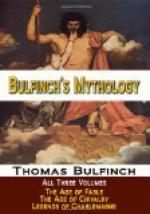MAIL ARMOR
Mail armor, of which the hauberk is a species, and which derived its name from maille, a French word for mesh, was of two kinds, plate or scale mail, and chain mail. It was originally used for the protection of the body only, reaching no lower than the knees. It was shaped like a carter’s frock, and bound round the waist by a girdle. Gloves and hose of mail were afterwards added, and a hood, which, when necessary, was drawn over the head, leaving the face alone uncovered. To protect the skin from the impression of the iron network of the chain mail, a quilted lining was employed, which, however, was insufficient, and the bath was used to efface the marks of the armor.
The hauberk was a complete covering of double chain mail. Some hauberks opened before, like a modern coat; others were closed like a shirt.
The chain mail of which they were composed was formed by a number of iron links, each link having others inserted into it, the whole exhibiting a kind of network, of which (in some instances at least) the meshes were circular, with each link separately riveted.
The hauberk was proof against the most violent blow of a sword; but the point of a lance might pass through the meshes, or drive the iron into the flesh. To guard against this, a thick and well-stuffed doublet was worn underneath, under which was commonly added an iron breastplate. Hence the expression “to pierce both plate and mail,” so common in the earlier poets.
Mail armor continued in general use till about the year 1300, when it was gradually supplanted by plate armor, or suits consisting of pieces or plates of solid iron, adapted to the different parts of the body.
Shields were generally made of wood, covered with leather, or some similar substance. To secure them, in some sort, from being cut through by the sword, they were surrounded with a hoop of metal.
HELMETS
The helmet was composed of two parts: the headpiece, which was strengthened within by several circles of iron, and the visor, which, as the name implies, was a sort of grating to see through, so contrived as, by sliding in a groove, or turning on a pivot, to be raised or lowered at pleasure. Some helmets had a further improvement called a Bever, from the Italian bevere, to drink. The VENTAYLE, or “air-passage,” is another name for this.




